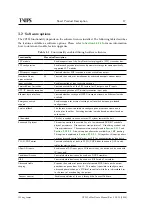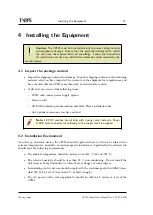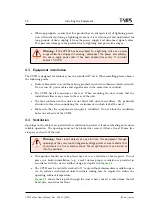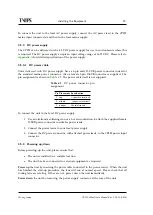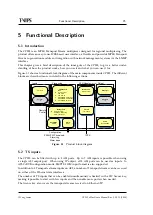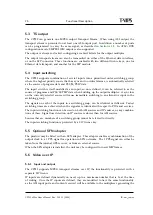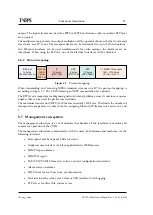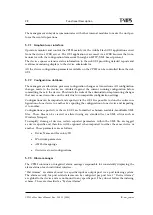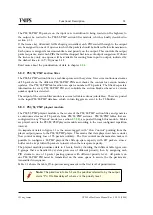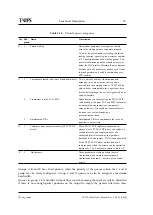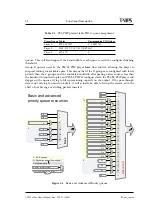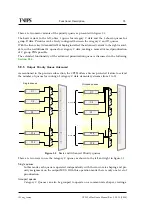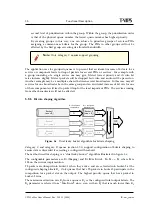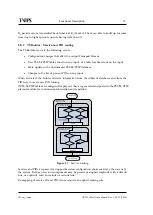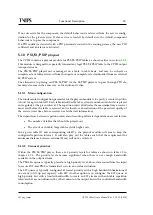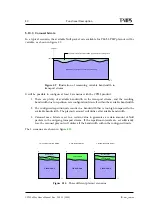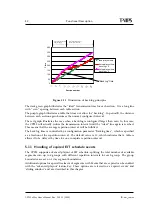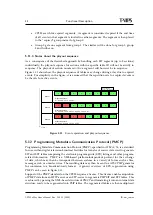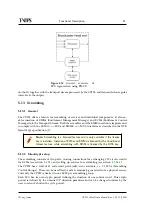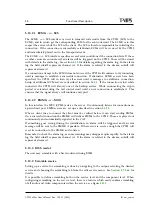
Functional Description
31
ID: um_tsmux
CP525 cMux User’s Manual Rev. 5.20.12 (3944)
The PSI/SI/PSIP TS packets on the input can, in addition to being routed on the highway to
the output, be routed to the PSI/SI/PSIP section filter module, which is briefly described in
section
.
If the licence key
Advanced traffic shaping
is installed, each PID routed through to the output
can be assigned to one of 15 queues in which the packets should be buffered before transmission.
Each queue is assigned a maximum bitrate and priority on the output. This controls the output
packet sequence, and which PIDs that will be dropped first in case of output congestion. Without
the licence key only one queue will be available for routing from input to output, indicated by
the dashed lines to A/V/D queues 2-15.
Read more about the prioritisation of data in chapter
5.9.2 PSI/SI/PSIP section filter
The PSI/SI/PSIP section filter is a real-time process in the system. It receives continuous streams
of TS packets on the different PSI/SI/PSIP PIDs and checks the content for version number
updates. One PSI/SI/PSIP table section can span a number of TS packets. The filter keeps state
information for every PSI/SI/PSIP PID and re-builds the section blocks whenever a version
number update is detected.
The output of the section filter module is re-created table sections (sub-tables). These are posted
to the input PSI/SI/PSIP database, which in turn triggers an event to the TS Builder.
5.9.3 PSI/SI/PSIP playout module
The PSI/SI/PSIP playout module is the reverse of the PSI/SI/PSIP section filter, and generates
a continuous streams of TS packets from PSI/SI/PSIP sections. PSI/SI/PSIP tables that are
configured in any “Playout” mode (see section
), are posted through this module. Tables
are played out via the PSI/SI/PSIP playout module according to the user configured repetition
interval.
An important detail in figure
is the arrow tagged with “Flow Control” pointing from the
player output queues to the PSI/SI/PSIP player. This means that data played out here is under
flow control making loss of TS packets unlikely. The flow control mechanism also makes it
possible to configure a SI/PSIP playout that fills up spare capacity with EIT packets, since a
buffer can be kept full with packets to insert when there is spare capacity.
The playout module prioritises data in 2 levels; first by dividing the different table types into
3 groups that are handled by system processes of different priority, then by assigning each
PID stream to one of 3 packet posting queues with different priority level. All packets on
one PSI/SI/PSIP PID must be transmitted on the same queue to assure the the packets are
transmitted in sequence.
Table
shows the table_ID-to-process assignement in the first level of prioritisation.
Note:
The priorities in table
are the priorities referred to by the output
alarm “Pri X tables delayed” where x is the priority level.
Содержание CP525 cMux
Страница 1: ...CP525 cMux User s Manual Revision 5 20 12 3944 2012 12 17 Valid for SW version 5 20 12 and newer ...
Страница 2: ......
Страница 10: ......
Страница 12: ...12 CP525 cMux User s Manual Rev 5 20 12 3944 ID um_tsmux ...
Страница 18: ...18 CP525 cMux User s Manual Rev 5 20 12 3944 ID um_tsmux ...
Страница 24: ...24 CP525 cMux User s Manual Rev 5 20 12 3944 ID um_tsmux ...
Страница 66: ...66 CP525 cMux User s Manual Rev 5 20 12 3944 ID um_tsmux ...
Страница 238: ...238 CP525 cMux User s Manual Rev 5 20 12 3944 ID um_tsmux ...
Страница 248: ...248 CP525 cMux User s Manual Rev 5 20 12 3944 ID um_tsmux ...
Страница 276: ...276 CP525 cMux User s Manual Rev 5 20 12 3944 ID um_tsmux ...

